Diamond Girdle Thickness And Why It Is Important
A diamond’s outermost edge is also known as the girdle. This thickness is measured as a percentage of the diameter (e.g. thin = 1.0%, medium = 3.0%, thick = 4.0% etc…) or described using words (such as Medium, Thick or Thin).
In a grading report, the finish of the girdle will also be stated and listed as one of the following: polished, faceted or bruted. This information can be found in the proportions diagram that looks like the example below.
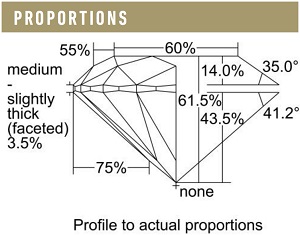
Why is the Diamond’s Girdle Thickness Important?
First of all, the ideal girdle thickness should not be too thin such that it causes a heightened risk of chipping. On the other hand, the girdle thickness shouldn’t be too thick as it will result in “dead weight” which makes the diamond appear smaller.
You should also beware of diamonds with extreme girdle thickness variations (e.g. very thin – extremely thick) as they usually indicate symmetry issues and poor cut. Besides lower optical performance, extreme variations can also cause problems during the setting process.
Did You Know That The Ratings Are Relative?
The girdle descriptions are relative to the size of the stone (i.e. diameter). In other words, a measured thickness of 0.31mm may result in a “Very Thick” rating for a 1/2-carat round diamond. However, a measured thickness of 0.31mm will result in a “Thin-Medium” rating on a 5-carat diamond.
If the girdle thickness is extremely thin, the facets junctions of the crown and pavilion facets meet together to form a knife edge. From a mechanical perspective, the diamond’s crystalline structure is weakest at knife edges and makes them very susceptible to damage.
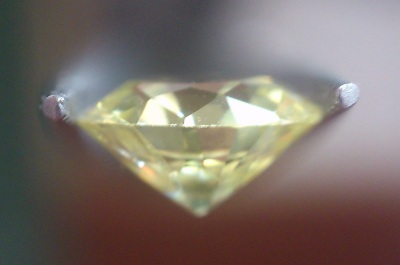
In the photograph above, the knife-edge girdle has nicks and chipping damage.
The finishing of the girdle may also create undesirable appearances for the diamond. For example, if a bruted girdle is sufficiently thick enough, it can cause an unsightly gray reflection to appear under the table facet.
As a general guideline, I only recommend buying diamonds with polished or faceted girdle finishing.
Diamond Girdle Size Chart Reference
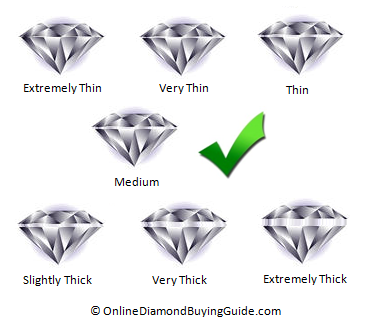
Here is a List of Acronyms Commonly Used
Girdle thickness is classified into categories ranging from extremely thin to extremely thick. Diamonds with girdles that lie in the outer regions of extremely thick and extremely thin have cut related issues in them. This is one of the reasons why such stones are usually less valuable and sell for a lot less.
- Extremely Thin – ETN, ETH, XTN, EXN
- Very Thin – VTN, VT, VETN
- Thin – T, TN, TH
- Medium – M, ME, MD, MED
- Slightly Thick – STK, ST, SLTK, SLTH
- Thick – T, TK, TH
- Very Thick – VTK, VTH
- Extremely Thick – ET, EXTK, XT, XTK
- Faceted – F, FA, FAC
- Smooth – S, SM
How is Girdle Thickness Described on a Grading Report?
The gemological labs assign a description based on the thickest and thinnest portions of the girdle. Also, it’s common to see variations in girdle thickness across a diamond instead of a nice uniform thickness throughout the diameter.
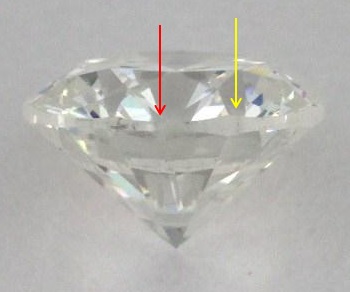
Slightly Thick – Very Thick
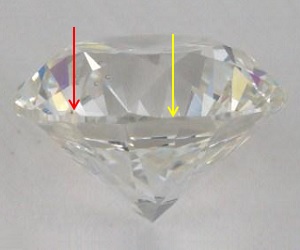
Very Thin – Thick
The above examples present 2 round brilliant cuts with different problems. The diamond on the left has weight retained at the girdle area and results in a smaller looking diamond from the face up view. The one on the right poses a serious durability problem due to the very thin section of the girdle.
Also, just by looking at these profile views, you can actually deduce that these diamonds have problems with their overall symmetry.
Comparison of 1 Carat Diamonds With Uniform Girdle Thickness
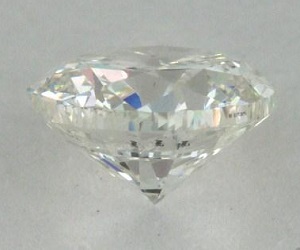
Ex. Thick – Measurement: 6.00 * 6.06 * 4.14 mm
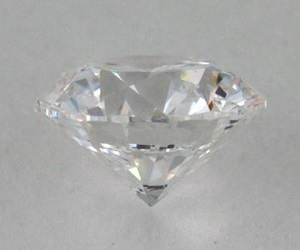
Medium – Measurement: 6.49 * 6.47 * 3.94 mm
An extremely thick girdle causes excessive weight retention which is hidden from sight after mounting. This is also one of the reasons why 2 stones with similar carat weight can face up completely different and have stark physical dimensions from each other.
Did you know that GIA’s grading system will penalize and downgrade the diamond’s cut rating because of the girdle thickness it has? Using the 2 examples above as references, the cut grade of the diamond on the left was graded as Fair while the one on the right received an excellent rating.
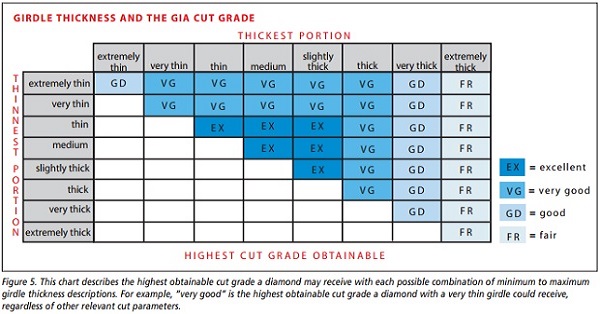
Note: This table is only applicable for round diamonds. Source: Culet And Girdle Assessment, GIA
Situations Where a Thick Girdle May Be Preferred
It is perfectly OK for diamond shapes such as the heart, pear or marquise to have thicker girdle thicknesses at the locations of the pointed edges. In this case, the extra thickness provides additional strength and acts as a form of protection against chipping.
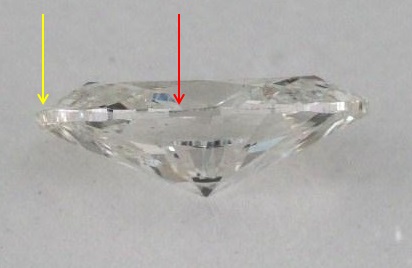

The girdle thickness increases near the tips of this marquise shaped diamond.
Summary: What I Would Personally Buy And Recommend
I know many people get hung up on finding a diamond with a “perfect” girdle when there’s actually no need to overthink stuff. So, here’s the bottomline when it comes to girdle thickness?
For round brilliant cut diamonds, you should only buy diamonds within the range of thin – medium – slightly thick girdles. That is to say, if you see a round diamond with a thin – slightly thick girdle, that’s perfectly fine. Likewise, if you see a thin – medium or medium – slightly thick girdle, that’s OK too!
For fancy shape diamonds, a girdle range of thin – medium – slightly thick – very thick would be recommended. I need to emphasize that it is alright to buy a fancy shape diamond with a very thick girdle as long as it is well cut.
At the end of the day, the girdle thickness is just a small aspect of choosing a well cut diamond. The more important things you should look out for when choosing a diamond is tangible data that determines cut quality and light performance.
Related Articles
Leave A Comment


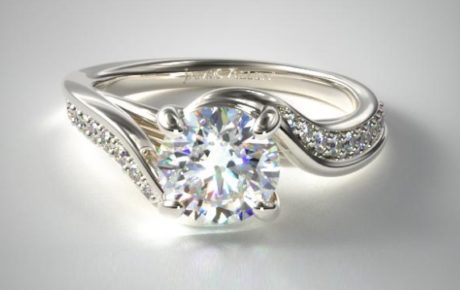
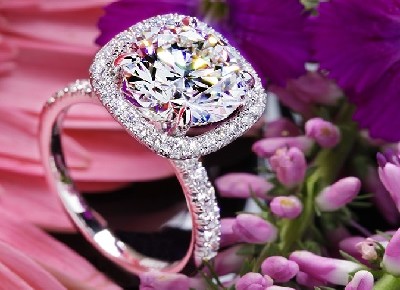
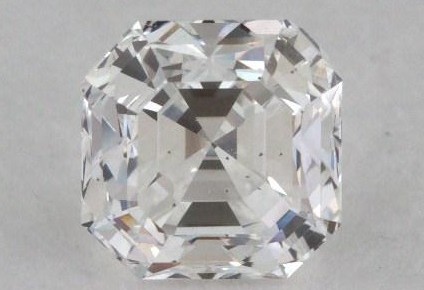









36 Comments
I had been browsing diamonds online for quite some time now and intend to buy one in the next few weeks. During my research, I had noticed many diamonds exhibit girdle thickness that seem to vary quite wildly from each other.
For example, thin – medium girdle thicknesses are typically seen in round diamonds. We see a larger fluctuation in fancy cuts such as thin – extremely thick, medium – slightly thick, thick – extremely thick, thin to very thick and the list goes on for girdle thicknesses.
I had read in your article on diamond girdle sizes and you mentioned that medium is the one we should go for. Based on my fiancé’s preferences, I had been looking at some fancy cuts lately and had seen some pretty nice ones at James Allen. However, the concern I have is that some of these shortlisted diamonds have girdle thickness from thin – very thick or medium – extremely thick.
Should I discount these diamonds and only select those with a medium girdle?
Hi Dreamer,
You had raised quite a number of points here and I will attempt to answer them one by one. Typically, I would avoid diamonds with an extremely thick girdle as there is a possibility the girdle can act as an extra facet of sorts. In poorly cut diamond, this can alter the diamond’s appearance in a way which is unpleasant and distracting to look at.
Next, if a diamond has a uniform girdle of ‘extremely thick’, I would advise you to avoid them. Such diamonds are overweight and you are basically paying for the “dead weight” that you can’t see once it is mounted.
For fancy cuts, if a diamond exhibits a girdle of medium – extremely thick, I wouldn’t avoid it ‘per se’ without knowing the rest of the diamond’s properties. This should be determined on a case to case basis.
Why?
Basically, the girdle is measured around the entire circumference of the diamond. The thinnest and thickest areas will be listed in the grading report. In the example above, the girdle of the diamond is ‘medium’ at its thinnest point, and ‘extremely thick’ at its thickest point.
Now, I wouldn’t totally write off a diamond in this case as it might not be detrimental to the stone’s outlook. You will need further data like ASET images and videos to determine whether it is a keeper.
I would however, always avoid diamonds that fall under these scenarios:
1) Any mention of Extremely Thin.
2) A uniform girdle thickness of Extremely Thick.
3) Huge deviations like Very Thin – Extremely Thick.
Hope this helps clarify things,
Paul
ps. when searching for fancy shaped diamonds, the odds are against you to buying a well-cut diamond. You need every tool at your disposal to make the best possible choices and I highly recommend JamesAllen.com because you can see exactly how the diamond looks like with their video technology. On top of that, they are able to perform gemological evaluations like light performance and capture ASET imagery on your behalf.
I’m so sorry I can’t seem to locate my last comment/question. I also wanted to see your thoughts on this diamond? Based on the dimensions will it appear larger than actual size. Is this a fair price, $17,500? Is the slightly thick faceted diamond any problem at all?
http://s3.amazonaws.com/rap.certs/gia/Certificates/2015/7/10/6177230593.pdf
There’s no way I can offer constructive feedback on a fancy cut oval diamond based on the grading report alone.
Read these in full:
https://beyond4cs.com/buying-diamonds-blind/
https://beyond4cs.com/shapes/oval/
What do you think about lab created diamonds at brilliantearth.com. Are they really optically, physically and chemically identical to earth mined diamonds? I was looking at https://beyond4cs.com/go/be-2718170/ and https://beyond4cs.com/go/be-2719148/
This second ones girdle is faceted. Would the second one be better? I spoke with my girlfriend and after reading about lab created diamonds she said that she would be okay with it.
Read this: https://beyond4cs.com/grading/girdle-thickness/does-finishing-matter/
By proportions alone, this would be the better diamond on paper.
Hi Paul,
When a diamond has a girdle thickness in the GIA report as medium to slightly thick (faceted) 4.0%
What does the % here mean?
Does the 4% here indicate the % at the slightly thick part of the girdle?
Why is there a single % number? Shouldn’t there be one for the medium and one for the slightly thick?
I read this http://diamondcut.gia.edu/pdfs/booklet_finish_culet_girdle.pdf
It talks about the % in general and how it is calculated. I don’t know what it means to have one number only.
Can you please help?
Thanks alot!
Girdle thickness percentage = total depth % – (crown height % + pavilion depth %)
Hi Paul – Appreciate all the content on what girdle is best for diamond. It’s been a huge help. I’m having a hard time finding out why the two listed below have a price difference. They are pretty much the same thing in terms of varying categories, details are below.
Would really like your take on these two…
https://www.bluenile.com/colored-diamond-details/yellow-LD05206579
1.56 Carats
Polish – Very Good
Symmetry – Very Good
Flour – None
Price – $14.7K
VS2
Depth – 64 (excellent 64 is perfect)
Table – 70 (very good)
Length to width – 1.12 (very good for a rectangle cut)
Girdle – Very Thick to Extremely Thick (fair)
Cutlet – None
https://www.bluenile.com/colored-diamond-details/yellow-LD08750917
1.52 Carats
Polish – Excellent
Symmetry – Very Good
Flour – None
Price – $12.7K
VS2
Depth – 68.8 (very good)
Table – 63 (excellent)
Length to width – 1.25 (very good for a rectangle)
Girdle – Thick to Very Thick (good)
Cutlet – None
Doug, the price differences could be a result of various factors. With yellow colored diamonds, you cannot buy or make decisions without videos/photograhs. This is because factors like color distribution, eyecleanliness, shape appeal and etc… cannot be deciphered.
This would shed more light: https://beyond4cs.com/fancy-colored/cushion-cut-fancy-intense-yellow-diamond-engagement-ring/
Hi there Paul, I’m looking at cushion cut diamonds under 1 carat and am tossing up between two on Blue Nile:
LD09315409 $3254
LD09355704 $2655
The cheaper stone has a thicker girdle and only a Good rating for symmetry, which I’m unsure about.
I’m not worried about a G colour as I will be setting in yellow gold and I heard that meant a whiter colour isn’t as important as if you were setting in white gold/platinum?
Hope you can give some advice!
Thanks,
Susie
Between the 2, this is the better cut diamond for light performance:
https://www.bluenile.com/diamond-details/LD09315409
You are right about the color issue with yellow gold setting. An F or G would still look yellowish in that setting. Anyway, color is not my primary concern here. Cut quality is. Go for the diamond above.
Paul: Can you advise me on whether to choose 14k or 18k yellow gold? Also, given I am going with yellow gold, can you guide me on how to choose. My primary concern is brilliance and the “look” to the naked eye. Size: 1.5 carat. Round. Set high with channel diamonds on each side. Also, does it matter that I match diamond color with channel diamonds color? Thanks!! I will buy on bluenile.
This write up has answers you need: https://beyond4cs.com/engagement-ring/differences-between-10k-vs-14k-vs-18k-gold/
Question: do all solitaire diamonds have a girdle reflection. If not, what do I need to consider to avoid this? What is the ideal girdle thickness for an oval? Would it matter if it is a 0.5ct or a 3ct diamond? Or what it be the same recommended thickness regardless? I’m looking for a three carat oval ring.
All diamonds will have a girdle reflection when seen from the profile view. The ideal girdle thickness for oval shapes and other fancy cuts should be between thin to very thick. It doesn’t matter what carat size you are buying as girdle thickness is measured as a relative to the diamond’s depth. Lastly, this article on shopping for a 3 carat oval diamond ring should help as well.
Hi Paul. Thank you for the info. What do you think of this JA oval?
https://www.jamesallen.com/loose-diamonds/oval-cut/2.15-carat-f-color-vs2-clarity-sku-4302126
It seems that there was an updated GIA report here where the SYMM was updated from good to very good: https://www.gia.edu/report-check?reportno=1275956429
I am waiting on an ASET image. I am not sure about the 6 facet pattern and the thin to medium girdle. What do you think? Seems there is no bowtie but wondering about fire and brilliance – and the girdle thickness. Thank you.
The grading reports are pretty inconsistent but I would assume that the one listed at GIA’s official website is accurate compared to the one uploaded by James Allen. Anyway, the diamond is pretty well cut for light performance and is a good choice. The bowtie is minimal and the girdle thickness is perfectly fine. Let me know again when you receive the ASET imagery from them.
I have a 40 year old diamond, now that I am older 65 and more aware of diamond 4 c’s-Thanks interent, I see an area of slight chips in one area on the girdle and on up to one facet on the crown and another area of a line on the girdle maybe a feather – looks like fissure so to speak very minuscule, question can the bearded area be polished out, the girdle here is thin or just put a bezel ring setting on it and forget about it. It was listed as SI1,H ,1.5 carats years ago. Was the bearding caused by wear and tear, I really never wore it that much or was it a bad cutting process to begin with? Maybe I should just throw it in the garbage, lol.
If you the diamond has a bearded girdle, it is unlikely to be caused by wear and tear. Most of the time, damage caused to the diamond result in nicks or chips. Polishing out a bearded girdle is relatively simple and results in small carat weight loss only. If the damage is a nick or chip, it is hard to say without looking at the diamond on the type of repairs that can be done. Your best way forward is to bring the ring for assessment with a jeweler.
Hi Paul, I was wondering if the Girdle for this diamond is negligible based on the rest of its attribute. I have been looking at E+, IF+ Cushion diamonds with a squarish shape. It is around the 5.75-6.5 mm range I have been looking for while trying to create a custom designed ring.
https://www.gia.edu/report-check?reportno=3365779141
For a fancy shape cushion cut diamond, girdle thickness that is slightly thick won’t be an issue. What is more important is its appearance and how the diamond is cut to interact with light. These are stuff that cannot be judged based on a grading report alone and you will need videos/scope data to help you assess that.
Hiya Paul, im looking at a round brilliant diamond 0.82 vvs1 D all excellent the GIA report shows a indented natural I have asked to see the plot on the report to locate it but have been told a diamond under one carat will mot show a plot on the report. Is an indedned natural a problem. Sku 10352166 I have this on hold from James allen. Thankyou
It is true that the diamond plot will generally not be available in grading reports for diamonds under 1 carat in size. This inclusion will however, be noted in the Clarity Characteristic section of the report. For a VVS diamond, inclusions are NEVER a problem. So, no worries there.
Hi Paul,
I wanted to know if I should avoid extremely thick girdles in coloured diamonds?
https://www.jamesallen.com/loose-diamonds/fancy-color/yellow/oval-cut/0.72-carat-si1-clarity-sku-10420356
https://www.jamesallen.com/loose-diamonds/fancy-color/yellow/pear-shaped/0.62-carat-si2-clarity-sku-3314397
https://www.jamesallen.com/loose-diamonds/fancy-color/yellow/pear-shaped/0.61-carat-si1-clarity-sku-7163082
These are the diamonds I have looked at so far.
..
For fancy colored diamonds, extremely thick and very thick girdles are OK and completely normal. Unlike colorless diamonds, thicker girdles are a strategy used by cutters to saturate the color of a diamond. So, don’t be alarmed when you see this phenomenon when buying a fancy color diamond. Out of the 3 stones, the 3rd option has the best color saturation and hue. It also has a lovely shape appeal.
I have a 2 carat Old European diamond solitaire ring bought at auction that has abrasions around the girdle. Color K-L, clarity SI1 but the girdle has several very small abrasions. I want to have it reset into something I like better and that will be less likely to have the girdle so exposed, but wonder if I should worry about the abrasions.
Will be interested in your thoughts.
Abrasions are usually not a big issue for durability concerns compared to large feathers. Without seeing the condition of the diamond in person, it is hard for me to give a proper assessment. Offhand, I won’t be worried about abrasions but the best person to speak to is a jeweler that is building the potentially new setting for you and get their opinion of it.
Hi Paul,
Thanks for all your valuable insight!
What are your thoughts on a ‘slightly thick’ 4% girdle on a natural round brilliant with otherwise optimal angles and proportions (per your other recommendations)? 1.08ct / F / VVS2. How do you weigh this 4% girdle vs other factors? Thanks!
The slightly thick girdle is perfectly fine for a round diamond. You need to be looking at other proportions and tangible data to determine the light performance of the diamond. The girdle alone and by itself holds little weight in whether a diamond has strong light return or not.
I have been offered a round Type 2a brilliant loose diamond stone 7.93 Carat (D flawless) which has a girdle that ranges from thin to medium. (faceted) 3.5%. Measures 12.79-12.85 x 7.87mm
The other option is a round brilliant loose diamond type 2b diamond (D flawless) 7.81 carat with girdle ranges from medium to slightly thick. (faceted 3.5%. Measures: 12.74-12.80 x 7.5 mm. Both are with GIA certificate D colour, Flawless, Excellent across the 3 cut criteria, more importantly both with ideal proportions. The difference between both if placed side by side is a tiny diameter of 0.05mm in diameter. I prefer Type 2a diamonds but am worried about the thin girdle and of course has no boron nor nitro impurities. I am almost ready to purchase the stone to be mounted on a platinum Tiffany style setting.
Please guide me as I understand a thin girdle is relative to the size of the stone. Thank you so much.
The thin to medium girdle is of no concern or worry to me as that is perfectly fine and normal. You seem to be shopping based on paper stats that can sound great and all that. I would pay attention to tangible data like ASET/H&A images to make sure that the diamonds are well cut. Placing your emphasis on the girdle thickness is not as important as focusing on cut quality data. As for Tiffany solitaire setting designs, there are plenty of jewelers offering that but only a few really make it well.
Hello,
Paper stats I’ve read say the ideal oval diamond would be very thin – slightly thick girdle. Is this true. I found a diamond that meets all my needs but now I’m concerned that it might be more fragile/delicate
Thank you
By itself, a very thin girdle is not a deal breaker and it really depends on a case by case basis. The risk of chipping does heighten. You would need to know how much of the girdle is actually very thin or whether it is just a small select area of it. The location of the very thin girdle in relation to the prongs and how it is mounted into a setting also plays a determining factor.
Hello,
I am looking at a 1.3 carat. The GIA info indicated measurements 7.01 – 7.06 x 4.33 mm. What does this refer to? Is this concerning?
Cut Grade is excellent and Symmetry is Very Good. However, the girdle is 2.5% thin to medium (faceted). I’m concerned the diamond might be more thinner is areas vs “medium”?
The setting is being designed to replicate Tacori RoyalT HT2607RD10, so will have a halo as well as a hidden halo. Would the measurements and the 2.5%, thin to medium, girdle be an issue?
Thank you in advance.
Imagine looking at the diamond from the top and you will see a perfect circle. This circle is the dimension that is being measured in the laboratory and indicated in the certificate. In real life, the perfect circle rarely exists when cutters polish a diamond.
The 7.01mm refers to the smallest diameter measured on the diamond. The 7.06mm refers to the biggest diameter measured on the diamond. There is always going to be some variance.
As for the girdle thickness, it is perfectly fine to see thickness of thin to medium. What is concerning is the cut quality of the diamond. And the Very Good symmetry is a tell tale sign of a mediocre stone.